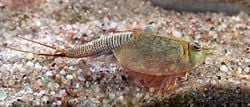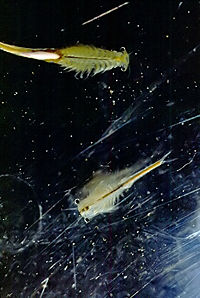Difference between revisions of "Branchiopoda" - New World Encyclopedia
Rick Swarts (talk | contribs) |
Rick Swarts (talk | contribs) |
||
| Line 23: | Line 23: | ||
}} | }} | ||
| − | '''Branchiopoda''' is a group of primitive | + | '''Branchiopoda''' is a group of primitive, aquatic, primarily [[freshwater]] [[crustacean]]s, mostly resembling [[shrimp]]. This taxon is generally placed as a class of the [[arthropod]] subphylum (or superclass) [[Crustacea]], but some taxonomic schemes recognize it as an order, with Crustacea listed as a class. Branchiopods should not be confused with the closely similarly spelled [[brachiopod]]s, which comprise an unrelated phylum ([[Brachiopoda]] of sessile, two-shelled, marine animals (lamp shells). |
| + | |||
| + | There are over 900 known species of branchiopods worldwide. A few are well-known, including ''Artemia'' ([[brine shrimp]], called ''[[sea-monkey]]s'' when marketed as novelties), and ''[[Daphnia]]'', both of which are raised as aquarium food or as interesting pets in and of themselves. | ||
==Overview and description== | ==Overview and description== | ||
Revision as of 14:58, 26 May 2008
| Branchiopods | ||||||||
|---|---|---|---|---|---|---|---|---|
 Triops, a notostracan
| ||||||||
| Scientific classification | ||||||||
| ||||||||
|
Branchiopoda is a group of primitive, aquatic, primarily freshwater crustaceans, mostly resembling shrimp. This taxon is generally placed as a class of the arthropod subphylum (or superclass) Crustacea, but some taxonomic schemes recognize it as an order, with Crustacea listed as a class. Branchiopods should not be confused with the closely similarly spelled brachiopods, which comprise an unrelated phylum (Brachiopoda of sessile, two-shelled, marine animals (lamp shells).
There are over 900 known species of branchiopods worldwide. A few are well-known, including Artemia (brine shrimp, called sea-monkeys when marketed as novelties), and Daphnia, both of which are raised as aquarium food or as interesting pets in and of themselves.
Overview and description
As with other crustaceans—crabs, lobsters, shrimps, copepods, krill, crayfish, etc.—barnacles are characterized by having branched (biramous) appendages, an exoskeleton made up of chitin and calcium, two pairs of antennae that extend in front of the mouth, and paired appendages that act like jaws, with three pairs of biting mouthparts. They share with other arthropods the possession of a segmented body, a pair of jointed appendages on each segment, and a hard exoskeleton that must be periodically shed for growth.
Crustaceans have three distinct body parts: head, thorax, and abdomen (or pleon), although the head and thorax may fuse to form a cephalothorax. The head bears two pairs of antennae, one pair of compound eyes and three pairs of mouthparts. The thorax and pleon bear a number of lateral appendages, including the gills, and the tail ends with a telson (last division of the body of a crustacean, but not a true segment)
Although a few species of water flea have adapted to a life in the sea, these crustaceans belong primarily in fresh water.
The number of thoracic segments varies from species to species. The structure of the reproductive, nervous and circulatory systems is primitive compared to other crustaceans. All branchiopods are free-living—there are no parasitic or sessile species. They are not adapted to life in subterranean waters or the deep sea.
Leptodora, a relatively large branchiopod, relies on its very transparent body for camouflage. It is so transparent that its shadow is said to be more visible than its body.
Clam shrimp live up to their name as they are often seen burrowed in the mud like mussels at the bottom of temporary ponds. They are so well adapted to this extreme way of life that they are able to reach adulthood within a few days after inundation under optimal conditions. They can reproduce sexually, hermaphroditically or parthenogenetically.[1]
Branchiopods in general are equipped with a ventral food groove, useful for suspension and filter feeding. The water current in the ventral food groove, used for breathing and feeding in most species, is produced by a battery of unspecialised legs. This is thought to resemble a very original way of living among the crustaceans.
Classification
Carcinologists have long debated the taxonomic status of crustaceans, sometimes assigning the group to one of the phylum, subphylum, and superclass level, with five, six, or even ten classes recognized (Hobbs 2003). Many also list the Crustacea as a class.
- Hobbs, H. H. 2003. Crustacea. In Encyclopedia of Caves and Karst Science. Routledge. Retrieved December 5, 2006.
Six classes of crustaceans are generally recognized:
- Branchiopoda — small, freshwater crustaceans, including brine shrimp (Artemia), water fleas (Daphnia sp.), and Triops (Notostraca).
- Remipedia — a small class restricted to deep caves connected to salt water, called anchialine caves.
- Cephalocarida — tiny, hermaphrodictic, shrimplike; horseshoe shrimp.
- Maxillopoda — various groups, including barnacles and copepods. It contains Mystacocarida and Branchiura, which are sometimes treated as their own classes.
- Ostracoda — small marine and freshwater animals with bivalve shells that covers the body, with only antennae and parts of limbs extending.
- Malacostraca — the largest class, with the largest and most familiar animals, such as crabs, lobsters, shrimp, krill and woodlice. This class is sometimes arranged into the orders Decapoda, Amphipoda, and Isopoda.
In some taxonomic schemes that consider the Crustacea to be a "class," these divisions are considered to be "orders."
In older classifications, the superorder Diplostraca was made up of the two orders Conchostraca and Cladocera. According to newer data, however, these orders may be artificial (at least in their present state) as some of their members seem to have a paraphyletic origin within the Diplostraca. For this reason, the order Conchostraca is no longer used.
Evolution

The oldest known species is a 500 million year old fossil fairy shrimp called Rehbachiella kinnekullensis. Fairy shrimps are also seen as the most original and primitive members of the class.
They probably originated in marine environments, but only those who migrated to fresh water survived. The fact that they are especially adapted to temporary pools and waters that are too extreme for other animals to live in (like salt lakes) indicates that they could have sought refuge in these places because they were unable to compete with or evade the more advanced groups of animals evolving in their original habitats. This resulted in a short generation cycle and small body size. The large branchiopods, Anostraca, Notostraca and Conchostraca (even if it the last one seems to be a partially artificial order) are considered to be the most primitive, and most of them are still unable to live in waters where there are fish and other advanced predators, since they are too slow and vulnerable to survive them. A few of them, however, have evolved to cope with this problem well enough to survive, even with predators around them. The small branchiopods, mostly represented by water fleas, have succeeded in becoming zooplankton in such a degree that waters filled with fish and other threats are no longer a problem. Their main defence is their high number thanks to their small size, ability to produce many offspring and short life cycle.
ReferencesISBN links support NWE through referral fees
- ↑ L. A. Zenkevich. The Animal Life (Zhizn' Zhivotnykh), Volume 2. Chapter 7 - Phylum Arthropoda.
http://animaldiversity.ummz.umich.edu/site/accounts/classification/Brachiopoda.html#Brachiopoda Myers, P., R. Espinosa, C. S. Parr, T. Jones, G. S. Hammond, and T. A. Dewey. 2008. Phylum Branchiopoda. The Animal Diversity Web (online). Accessed May 26, 2008 at http://animaldiversity.org.
http://animaldiversity.ummz.umich.edu/site/accounts/classification/Branchiopoda.html#Branchiopoda Myers, P., R. Espinosa, C. S. Parr, T. Jones, G. S. Hammond, and T. A. Dewey. 2008. Class Branchiopoda (branchiopods)The Animal Diversity Web (online). Accessed May 26, 2008 at http://animaldiversity.org.
| |||||||||||||||||
Credits
New World Encyclopedia writers and editors rewrote and completed the Wikipedia article in accordance with New World Encyclopedia standards. This article abides by terms of the Creative Commons CC-by-sa 3.0 License (CC-by-sa), which may be used and disseminated with proper attribution. Credit is due under the terms of this license that can reference both the New World Encyclopedia contributors and the selfless volunteer contributors of the Wikimedia Foundation. To cite this article click here for a list of acceptable citing formats.The history of earlier contributions by wikipedians is accessible to researchers here:
The history of this article since it was imported to New World Encyclopedia:
Note: Some restrictions may apply to use of individual images which are separately licensed.